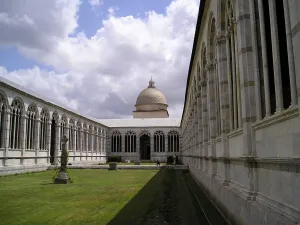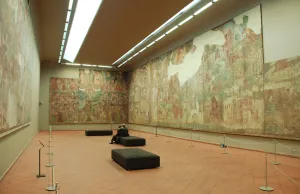Ars Longa: Documenting a Trove of Frescoes Nearly Lost to War
October 4, 2021
By Sarah Bigler, Photoarchivist
The Camposanto (“Holy Ground”) at Pisa has stood for more than seven hundred years, located in the same complex as the city’s cathedral and its famous leaning tower. A burial site since the Middle Ages, the Gothic building (above) was constructed beginning in 1277. Over the course of the fourteenth and fifteenth centuries, the structure became a veritable art gallery showcasing the tours de force of Early Italian Renaissance fresco painting, its interior walls covered in allegorical, biblical, and classical scenes. Totaling more than 2,600 square meters—over five times the size of the Sistine Chapel ceiling—the frescoes showcase the work of many influential artists from different regions of Italy, including Buonamico Buffalmacco (active ca. 1315–1336) and Benozzo Gozzoli (ca. 1421–1497).
Because of the Camposanto's enormous significance to the history of art, the Frick Art Reference Library’s Photoarchive holds more than one hundred reproductions of the building’s fresco cycles. Acquired in the 1920s and 1930s, the images come from the Italian photography firm Fratelli Alinari and from James Anderson, a British photographer working in Rome. The earliest of these photographs document the condition of the frescoes around 1890.
Having survived more than six turbulent centuries relatively unscathed, the Camposanto fell victim to the devastations of the Second World War. On the night of July 27, 1944, during the Allies’ Italian campaign, a stray shell hit the roof of the marble-clad structure, and within moments it was entirely engulfed in flames. The fire lasted a full three days. A 1945 edition of The Burlington Magazine described the gruesome scene:
“Blazing beams crashed against the frescoed wall-surfaces, molten lead ran down upon the pavement and on to the marble monuments ranged along the walls, cracking them into fragments with the heat.”
Further damage was sustained from shelling in September and October 1944. By the end of the war, the toll on the frescoes was severe. Unlike canvas paintings or freestanding sculptures, frescoes like the ones at the Camposanto were painted on wet plaster that dried into the walls of the building and thus could not be relocated for their safety. The heat from the fire had altered the paintings’ colors and caused the surfaces to blister. Large chunks of plaster had begun to pull away from the walls, completely detaching in some places.
After the war, the Frick Art Reference Library commissioned new photographs of the Camposanto frescoes to record their drastically altered conditions. As part of the library’s involvement in the efforts to save cultural sites during World War II—made famous by the so-called Monuments Men of the U.S. Army’s Monuments, Fine Arts, and Archives program—the Photoarchive’s goal of preservation continued into peacetime, in keeping with its mandate to document as many works of art as possible as their conditions evolved over time.
In 1945, under the direction of Lieutenant Frederick Hartt (a member of the Monuments Men), photographer Mario Sansoni captured the damage sustained by the Camposanto fire. These before-and-after comparisons, made possible by the Photoarchive’s holdings that depict the site over time, allow us both to study the frescoes prior to their destruction and to understand and visualize the extent of the damage.
In 1946, some of the photographs taken by Sansoni for the library were included in The Metropolitan Museum of Art’s exhibition The War’s Toll of Italian Art (October 18 to November 24, 1946), which raised funds for the restoration of Italian monuments damaged in the war. In a letter from July 1946, Millard Meiss, Co-Chairman of the American Committee for the Restoration of Italian Monuments and member of the Monuments Men, appealed to Helen Clay Frick, founder of the Frick Art Reference Library, asking her to lend photographs for the exhibition. He described the Frick’s Sansoni photographs as “the best photographs of the damaged Camposanto frescoes.”
These images take on even more importance to the history of the site given that the restoration process at the Camposanto began almost immediately, stretching through the entire second half of the twentieth century. Pieces of plaster that had fallen off the walls were collected and mounted on canvas, so they could be reunited later. Some of the frescoes were detached from the walls entirely, revealing the original underdrawings beneath. However, many of the methods used in the early conservation efforts led to problems down the line. The new supports used for the frescoes contained asbestos, and issues with the calcium-based glue used to reattach the frescoes had caused a white layer of salts and mold to form on their surfaces. To address all of these issues, another phase of restoration took place from 2009 to 2018.
At the Camposanto today, a few patches of blank plaster remain where portions of the original frescoes were lost, but the decades of restoration have camouflaged much of the paintings’ tumultuous history, returning them to an approximation of their original splendor. As much as visitors gained through the extensive restorations, the historical record lost significant physical evidence, rendering the series of photographs taken by Sansoni for the Photoarchive in 1945—the short period between destruction and repair—all the more crucial. The Photoarchive’s images preserve a brief moment in the long history of the Camposanto, essential for future study of the site, of preservation practices, and of the cultural losses of war.
The Photoarchive is the founding collection of the Frick Art Reference Library, comprising reproductions of more than one million works of art. Ars Longa is a blog series exploring the documentation of lost, altered, and destroyed works—as well as those in private collections or otherwise not easily accessible—highlighting the Photoarchive as an invaluable resource for the public.
Sources
Bowling, Melissa, and James Moske. “In the Footsteps of the Monuments Men: Traces from the Archives at the Metropolitan Museum.” metmuseum.org, 31 January 2014.
The Burlington Magazine for Connoisseurs, February 1945, vol. 86, no. 503, pp. 33, 35–39.
Hoeniger, Cathleen Sara. “The Camposanto of Pisa in the Wake of World War Two: Loss and Discovery.” In Art and Experience in Trecento Italy, eds. Holly Flora and Sarah S. Wilkins, 2018, pp. 313–328.
Meiss, Millard. Letter to Helen Clay Frick, July 2, 1946. Frick Art Reference Library Central Correspondence, The Frick Collection/Frick Art Reference Library Archives.
Poeschke, Joachim, Antonio Quattrone, and Ghigo Roli. Italian Frescoes: The Age of Giotto, 1280–1400. New York: Abbeville Press, 2005.






